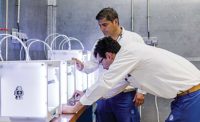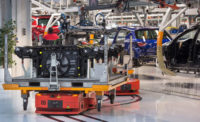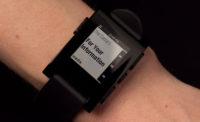New manufacturing technology should do more than just increase output, efficiency and quality. It should also improve the working conditions and health of the employees. This is why more and more manufacturers are investing resources to improve ergonomics on the assembly line.
Among those companies is IVECO S.p.A., a manufacturer of industrial vehicles based in Turin, Italy. A subsidiary of CNH Industrial Group, IVECO designs and builds light-, medium- and heavy-duty commercial vehicles; quarry and construction site vehicles; city and intercity buses; and specialty vehicles for firefighters and the military. With factories in 11 countries throughout Europe, Asia, Africa, Oceania and Latin America, IVECO produces some 150,000 commercial vehicles annually. All of the company’s plants have obtained ISO 9001 quality management certification and ISO 14000 environmental management certification.
One of IVECO’s flagship factories is its assembly plant in Brescia, Italy. It was originally built in the early 1900s by Officine Meccaniche, a car and truck manufacturer that became famous for producing the car that won the first edition of the Mille Miglia race in Italy in 1927. Subsequently, Officine Meccaniche directed its activities to making industrial vehicles. It became part of what was then the Fiat Group and, in 1975, it joined forces with four international automobile brands—Fiat Veicoli Industriali and Lancia Veicoli Speciali (Italy), Unic (France) and Magirus-Deutz (Germany)—to create IVECO, an acronym that stands for Industrial Vehicle Corp.
During all these changes, the Brescia plant has always played a strategic role, taking on new products and adopting and developing new production strategies and technologies. Indeed, the Eurocargo medium-duty truck, one of IVECO’s best-selling vehicles, was created at the Brescia plant in 1991 and is still being produced there.
Production of the Eurocargo starts in the bodywork department, where various stamped panels are welded together to build the cabin of the vehicle. Once assembled, it enters the painting area, a fully automated line where six robots apply enamel to the body after a cataphoresis electro coating process. Later, the cabin is moved to a second assembly line, where the seats, dashboard and other interior components are installed.
In the meantime, the chassis is being built in another department. After welding, the frame enters another assembly line where the engine, gearbox, power pack, suspension system and mechanical components are mounted.
The cabin and chassis complete their assembly cycles at the same time, and are paired up during final assembly.
Total Efficiency
“The production of Eurocargo makes us proud, because its huge range of configurations allows us to offer our customers about 13,000 different versions, with a repeatability index of about 2.85 for 2019,” explains Marco Colonna, manager of the Brescia assembly plant. “In other words, it’s very rare that two identical vehicles are delivered at the same time.
“Obviously, keeping high production efficiency with such significant product variability is not simple. It requires a structured logistics organization, because many materials are delivered to the various stations on a just-in-time basis and according to the production cycle. Consequently, the flow of information must be managed correctly to ensure that everyone knows what to do at any given time and has all the necessary tools available for their tasks.”
Accurate and efficient organization is a hallmark of the world-class manufacturing (WCM) philosophy, a strategy that incorporates the methodologies of total productive maintenance, lean manufacturing and total quality management.
“WCM is a production approach that involves the company at every level and function, from production to safety, logistics and maintenance activities,” explains Paolo Gozzoli, WCM plant support manager for IVECO. “The goal is to achieve efficiency in every department in an integrated way by means of tests and tools to manage specific inefficiencies. All our workforce must be involved and made aware that everyone’s contribution is essential to the improvement of business efficiency.”
One area of the plant that was recently targeted for improvement was the Daily Minibus assembly line. The minibus is available with four engines and 380 configurations, and production of the vehicle was “almost artisanal,” says Gozzoli. Engineers wanted to standardize as much as possible.
Engineers also wanted to improve the working conditions of assemblers. “This assembly process features many activities that must be carried out while lifting the arms,” says Gozzoli. “These activities are demanding for anyone, but they required even more attention from us because the average age of IVECO employees is around 49 years. We needed to make the work on minibuses as less burdensome as possible.”
To improve the line, engineers collaborated with IVECO’s Ideal Production System team, which is tasked with researching new manufacturing ideas and tools. IVECO likes to be at the forefront when it comes to adopting new technology, whether it’s a new machining process or a device to improve employee health and safety.
A Foreseen Success
While attending the Automatica trade show in Munich in June 2018, IVECO’s engineers were impressed by the MATE, an innovative wearable exoskeleton designed by robotics and automation company Comau. Could the device address the ergonomic issues on the minibus assembly line?
“During the event, we looked at different types of exoskeletons, but Comau’s MATE immediately stood out as the ideal solution for our needs,” says Gozzoli. “First of all, we required a tool that could help our operators with activities involving the upper limbs without reducing their mobility due to its structure or size. Another crucial feature for us was our conviction that a wearable device should be easy to wear and lightweight. We also had to consider the summer heat. Comau’s exoskeleton meets all these requirements.”
The exoskeleton is the result of a partnership between Comau; Össur, a manufacturer of noninvasive orthopedic devices; and IUVO, a spin-off company of the BioRobotics Institute of the Sant’Anna School of Advanced Studies in Pontedera, Italy.
The exoskeleton has an advanced, spring-based passive structure. The lightweight structure fully follows the movements of the upper limb without resistance or misalignment. Compact and breathable, the device delivers postural support without the need for batteries, motors or other failure-prone devices. The exoskeleton is fully able to replicate any movement of the shoulder while adhering to the body like a second skin.
The device enables assemblers to perform repetitive, strenuous tasks with less fatigue, and less fatigue equates to better quality and higher precision over the course of a shift. Tests have shown that the MATE reduces shoulder muscle activity by up to 50 percent. The MATE does not allow workers to lift more weight than they could before. Rather, it is designed to improve assemblers’ endurance and reduce the amount of fatigue they experience over the course of the work day.
“MATE has been designed in close collaboration with factory workers, responding directly to their specific needs,” says Nicola Vitiello, an associate professor at the BioRobotics Institute and one of the co-founders of IUVO. “With the exoskeleton, they will be able to do the same tasks, but with less fatigue.”
The MATE is the first of a series of wearable robotics that Comau is developing in partnership with IUVO and Össur. The goal of the partnership is to evolve human-machine collaboration within diverse sectors, including biomedical, manufacturing and consumer applications.
After a positive first impression at the show, IVECO assessed the potential of MATE at its Brescia plant, trying to identify the most suitable tasks for the exoskeleton. An app developed by Comau helped IVECO’s engineers quickly and objectively identify how the device could help in carrying out a given task.
“We have a long-term relationship with Comau,” says Gozzoli. “Indeed, we have 116 Comau robots in our factory. This partnership represents a privilege for us, because we are among the companies that get to use Comau’s innovative products first. In some cases, we can even test them before they are introduced in the market, as was the case with the MATE assessment app, which has allowed us to quickly identify the most suitable tasks for the use of an exoskeleton.”
Reduced Fatigue
Following the apps recommendations, IVECO engineers provided MATE to some of the operators involved in the assembly of minibuses. After using the exoskeleton for just a few hours, they immediately noticed a clear improvement in their working conditions. In one specific station, operators are assisted by MATE in the placement of reinforcements and accessories in the upper part of the minibus. For these tasks, the operators must keep their arms raised overhead, resulting in trapezius-deltoid muscle fatigue. This fatigue was immediately reduced by the exoskeleton.
The ergonomic improvement is witnessed everyday by the operators who count on the support of MATE, including Antonio Maccarinelli, the team leader for Section 1 of the minibus line.
“I have used the MATE exoskeleton for a few months now, and I must say that I immediately found relief, especially for my shoulders,” says Maccarinelli. “When mounting the reinforcements in the upper part of the vehicle, I have to keep my arms raised for a long time, often while I’m holding the tools I need to mount the various components. Even though they are all light objects, at the end of my shift I always noticed that this apparently minimal effort took its toll on my body.
“Now, my shoulders are in an excellent condition. Moreover, I must say that the device is really easy to wear. It’s like carrying a backpack, and it just needs a few initial settings to be immediately operational. Adjusting the shoulder straps is also quick and easy, which is really important, because I share MATE with other operators. Each of us has a slightly different build, but we can easily adapt it and feel comfortable.”
IVECO is not the only manufacturer that is testing the merits of the MATE. The device is also being used by a wide range of companies, including Faro S.p.A., a manufacturer of dental lighting and instruments in Ornago, Italy, and CC Jensen, a manufacturer of oil filters for large ships and wind turbines in Svendborg, Denmark.
For more information on the MATE exoskeleton, call Comau at 888-888-8998 or visit www.comau.com.







